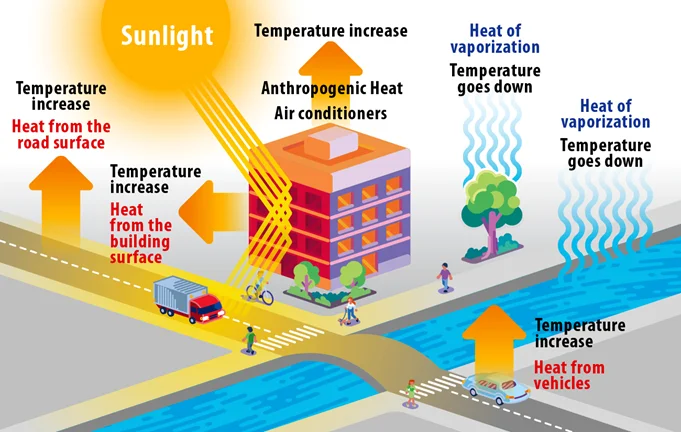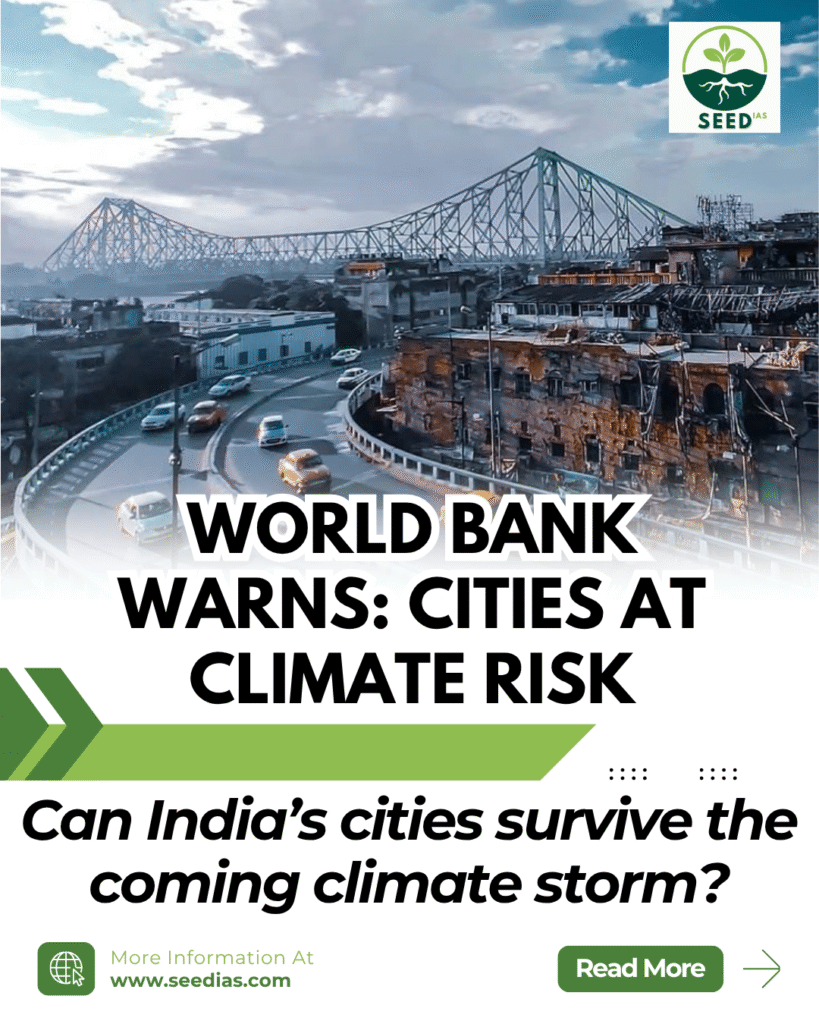Why in NEWS
A joint World Bank–MoHUA report, “Towards Resilient and Prosperous Cities in India”, warns that by 2030, Indian cities will create 70% of new jobs but face severe risks from floods, heatwaves, and poor air, urging urgent climate-resilient reforms and stronger urban autonomy.
Key Terms/Concepts
| Term | Explanation |
|---|---|
| Urban Heat Island | Cities become hotter due to concrete surfaces and reduced greenery |
| ULBs | Urban Local Bodies — local governments responsible for urban governance |
| AMRUT 2.0 | Scheme promoting green spaces and water infrastructure in cities |
| NMSH | National Mission on Sustainable Habitat — urban climate resilience mission |
| GIS | Geographic Information System — used for digitized urban property and planning |
| Smart Cities Mission | Urban initiative for smarter, sustainable city infrastructure |
| India Cooling Action Plan | Strategy to manage rising cooling demand with energy-efficient tech |
Key Climate Risks Impacting Indian Cities
| Risk | Impacts |
|---|---|
| Urban Growth | Population to reach 951 million by 2050; USD 2.4 trillion needed for resilience |
| Flooding | Annual flood losses may hit USD 5 billion by 2030 and USD 30 billion by 2070 |
| Heatwaves | Urban heat island effect may cause 3 lakh deaths/year by 2050 |
| Air Pollution | India had 42 of the 50 most polluted cities in 2023, causing respiratory illnesses |

Challenges of Urban Autonomy
| Challenge | Explanation |
|---|---|
| Weak Devolution | States haven’t fully empowered ULBs despite 74th Amendment |
| Low Revenue | Property tax <0.2% of GDP; GST reduced local fiscal powers |
| Capacity Gaps | ULBs lack trained staff, technology, and data access |
| Fragmented Governance | Poor coordination between departments weakens response |
Strategies for Urban Climate Resilience
| Strategy | Description |
|---|---|
| Greater Autonomy | More powers help cities raise resources and act locally |
| Urban Design | Parks, wetlands, climate-zoning to prevent flooding and heat stress |
| Risk Assessment | Heat action plans, geospatial data, and early warning systems |
| Resilient Buildings | NMSH and Cooling Plan to promote green and efficient infrastructure |
| PPP Investments | Private sector partnerships to fund and implement resilience projects |
In a nutshell
Memory Code: HEAT-UP
H – Heat & Air pollution control
E – Efficient buildings
A – Autonomy for ULBs
T – Tax reforms for funding
U – Urban planning
P – Public-private partnerships
Prelims Practice Questions
- Which of the following is not a feature of the Urban Heat Island effect?
a) Elevated nighttime temperatures
b) Increased green cover
c) Heat absorption by concrete
d) Reduced cooling at night - According to the World Bank report, Indian cities may face flood-related losses up to:
a) USD 3 billion by 2030
b) USD 30 billion by 2070
c) USD 50 billion by 2050
d) USD 10 billion by 2040 - Which constitutional amendment provided the framework for empowering ULBs in India?
a) 73rd Amendment
b) 44th Amendment
c) 74th Amendment
d) 86th Amendment
Mains Questions
- “Indian cities are engines of growth but also hotspots of climate vulnerability.” Analyse in the context of the World Bank’s findings. 10 Marks (GS1 – Urbanisation & GS3 – Environment)
- Discuss the role of Urban Local Bodies (ULBs) in making Indian cities climate-resilient. Suggest measures to strengthen their institutional and financial capacities. 15 Marks (GS2 – Governance & GS3 – Infrastructure)
Answers with Explanations (Prelims)
| Ques | Answer | Explanation |
|---|---|---|
| 1 | b) Increased green cover | Urban heat islands are due to lack of greenery |
| 2 | b) USD 30 billion by 2070 | Projected flood-related losses without adaptation |
| 3 | c) 74th Amendment | Empowered ULBs with 18 functions including planning |
















